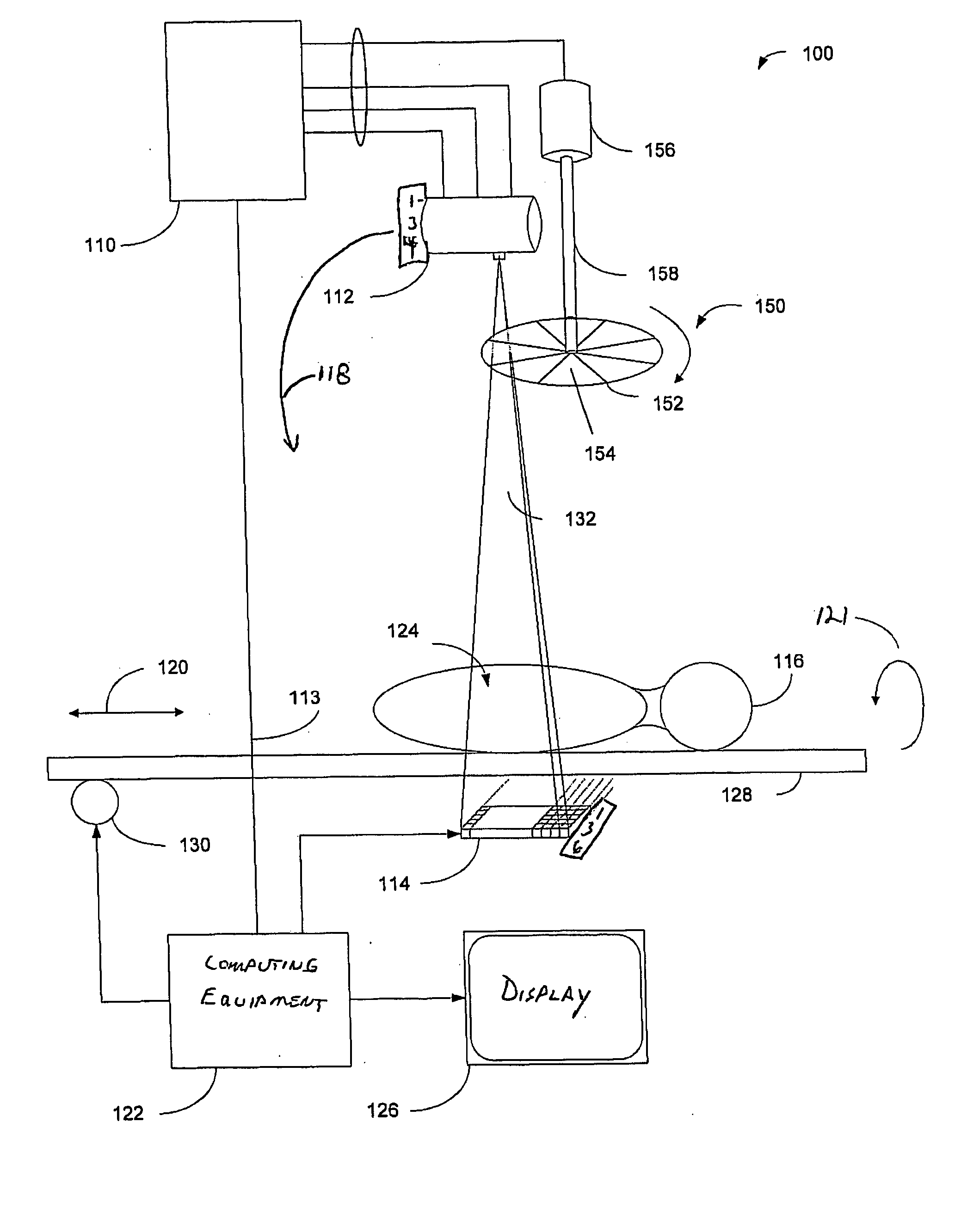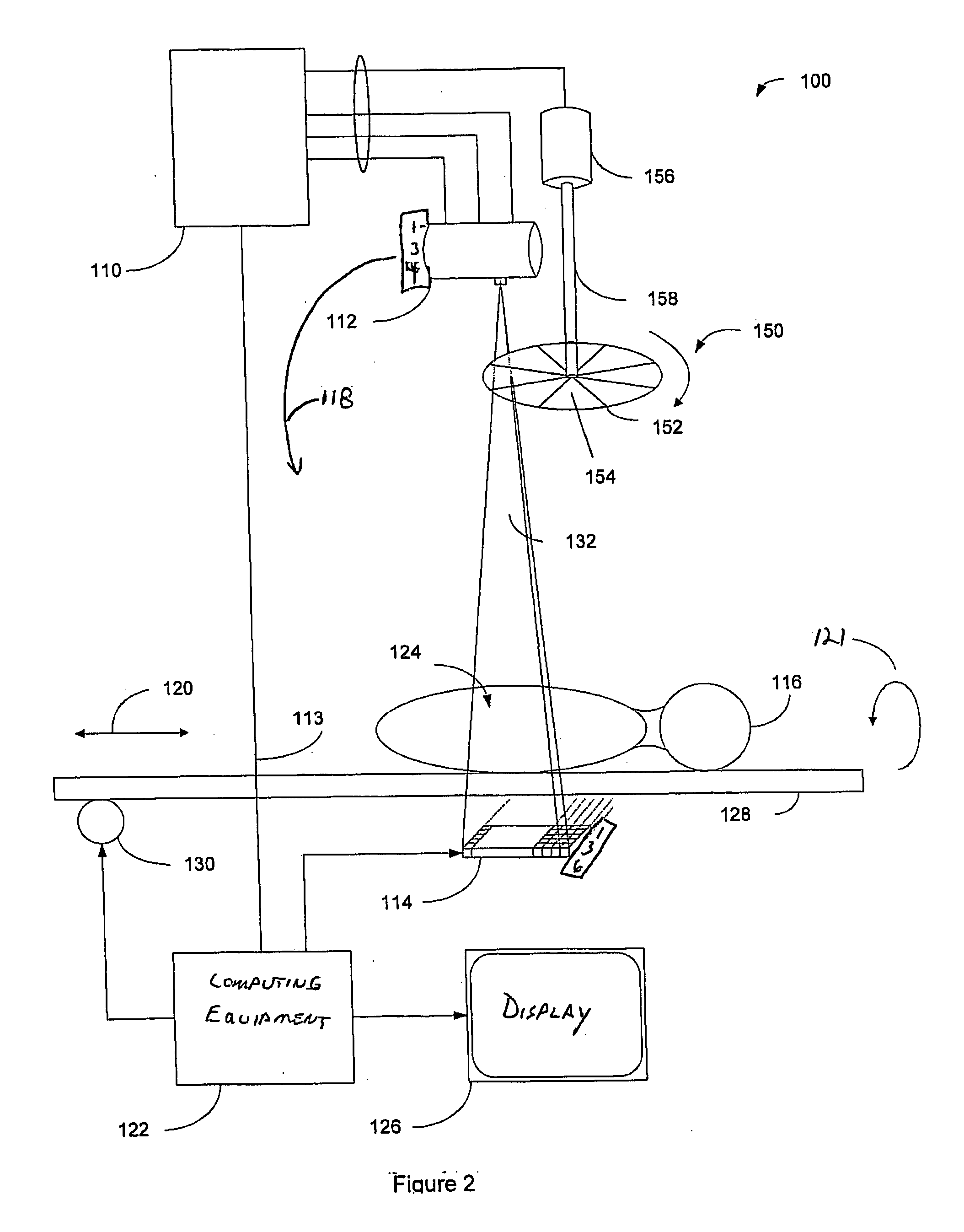Dynamic multi-spectral imaging with wideband seletable source
a multi-spectral, wideband technology, applied in the direction of instruments, patient positioning for diagnostics, applications, etc., can solve the problems of inability to separate each event, measurement lack quantitative accuracy, and the likelihood of significant changes in patient outcomes
- Summary
- Abstract
- Description
- Claims
- Application Information
AI Technical Summary
Problems solved by technology
Method used
Image
Examples
example 2
Single-Scan Dual-Energy Imaging
[0231] Initial multi-spectral investigations were modeled with a dual-energy scan configuration, using typical spectra as obtained at 120-kVp and 2-mm Al and 3-mm Cu filtration; and 60-kVp and 2-mm Al filtration, respectively. With a beam width of 10-mm at the detector, and a pixel size of 127-.mu.m, the primary beam illuminated 79 pixels and the effective exposure time was 315-ms for any point in the object. Tube currents of 12 and 6-mAs at 120 and 60-kVp respectively led to a (constant) tube current of 60-mA, and 52 and 26 samples at 120 and 60 kVp respectively. Tables 4 and 5 below list various model input parameters and output relating to the phantom, dual-energy techniques, filtration, and detector parameters.
4TABLE 4 Phantom, techniques, and filtration parameters for dual-energy single scan acquisition Beam width pixel size Readout Exposure Time mm microns # of pixels ms ms Tube mA Scan Length Scan time 10 127 79 4 315.0 57 430 13.5 kVp: 120 60 m...
example 3
Single-Scan Imaging with Six Spectra
[0234] A simulated a six-spectra acquisition is shown below for illustration of how this methodology may be applied in a more general sense. Tables 6 and 7 list the corresponding spectral characteristics. In this experiment, two additional low-energy spectra were designed to have mean energies just below and just above the K-edge of Iodine.
6TABLE 6 Techniques for a six-spectra AAPM chest phantom simulation Beam width pixel size Readout Exposure Tube current Scan length Scan time mm microns # of pixels ms ms mA mm seconds 12 127 94 6 566.9 120 430 20.3 kVp: 140 120 100 80 60 40 Total Al: Al 5 5 5 4 5 5 Filter Al-filt: 2 2 2 1 2 2 Filter Cu 5 5 4 1 0 0 Filter Ce 0.4 0 Filter Hafnium0.2 Filter iodine 0.1 Phantom Acrylic 100 100 100 100 100 100 Phantom Water 0 0 0 0 0 0 Phantom Al 3 3 3 3 3 3
[0235]
7TABLE 7 X-ray characteristics of a six-spectra AAPM-phantom simulation Air exposures Settings: kVp: 140 120 100 80 60 40 140-120 mAs: 5 7 15 6 15 20 (or su...
example 4
Single-Scan Dual-Energy Imaging--Second Example
[0237] The filtration for the 60-kVp spectrum of Example 2 and 40-kVp spectrum of Example 3 were retained for a second dual-energy simulation. A layer of 10-cm of water was added to the AAPM phantom definition to simulate a larger patient. (Tables of input and output parameters not shown.) The mAs techniques were increased as compared to the first dual-energy experiment (10- and 20-mAs at 60- and 140-kVp in this simulation as compared to 6- and 12-mAs at 60- and 120-kVp). The entrance air-kerma was raised from 120-.mu.Gy to 140-.mu.Gy; the absorbed signal SNRs decreased to 5.6 and 11 for the low- and high-energy beams, as compared to 26 and 24 respectively. The entrance exposure to the detector (total 1.3-.mu.Gy) showed the effect of the increased attenuation introduced by the 10-cm water layer; this effect was compensated in part by the Csl larger absorption at lower energies (absorbed mean energies of 46- and 101-keV respectively). Fo...
PUM
 Login to View More
Login to View More Abstract
Description
Claims
Application Information
 Login to View More
Login to View More - R&D
- Intellectual Property
- Life Sciences
- Materials
- Tech Scout
- Unparalleled Data Quality
- Higher Quality Content
- 60% Fewer Hallucinations
Browse by: Latest US Patents, China's latest patents, Technical Efficacy Thesaurus, Application Domain, Technology Topic, Popular Technical Reports.
© 2025 PatSnap. All rights reserved.Legal|Privacy policy|Modern Slavery Act Transparency Statement|Sitemap|About US| Contact US: help@patsnap.com



